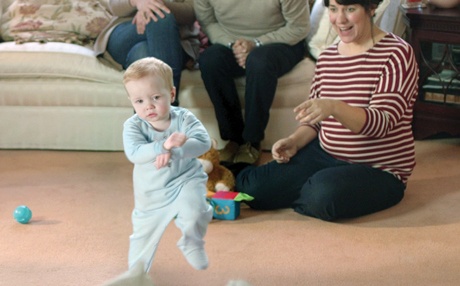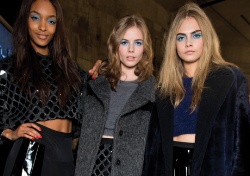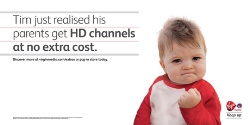Gangnam Style marketing
Borrowing from video dance crazes is becoming popular in marketing but how do brands use them in a way that matches their strategies?
Whether it is the Harlem Shake[1], Gangnam Style[2], Fenton the dog[3] or Success Kid, internet memes by their nature have captured the imagination of audiences worldwide.
As fast-growing and eminently shareable sources of entertainment, brands have seen the advantage of capitalising on these ready-made cultural phenomena.
Success Kid has starred in an ad for Virgin Media, Fenton’s mad deer chase in a London park has been re-imagined by EE[4], a baby broke into Gangnam Style dance moves for electronic cigarette firm E-Lites[5], and a host of brands, including Topshop[6], Pepsi, Lynx[7] and Ask.com, have created their version of the dance video Harlem Shake, albeit to varying degrees of applause.
“Memes are contagious and therefore inherently social,” says Virgin Media director of advertising and sponsorship Richard Larcombe. “With the increasing number of social sharing platforms, sharing is becoming quicker and easier and people are engaging with and sharing more content as a result. Advertising always follows culture and brands are seeing the opportunity and taking advantage of it.”
Authenticity is heralded as one of the most vital ingredients when using memes in marketing and it is that which has made some versions of the Harlem Shake work better than others, says Topshop chief marketing officer Justin Cooke (see Q&A).
“Online content is about capturing the moment, but honestly. It has to be real, you can’t force it,” he says.

A baby breaks into Gangnam Style dance moves in electronic cigarette brand E-Lites’ TV ad
The fashion chain’s video[8] features models Jourdan Dunn, Cara Delevingne and Rosie Tapner backstage at the brand’s autumn/winter 2013 fashion show. It had the spontaneity element that is common in other Harlem Shake videos, and provided behind-the-scenes footage of the show.
Cooke adds: “It made perfect sense for us and I think people love the authenticity of the way we do things. But for a lot of brands this would be completely irrelevant because they don’t have the same character in their DNA.”
YouTube UK managing director of sales and operations Kevin Mathers agrees that authenticity is essential and suggests that if Topshop’s video had been staged, it might not have been so successful.
He says: “Marketers are interested in engaging with their audience and part of that is tapping into themes that resonate with them, whether that’s being associated with the content they watch individually or taking advantage of a global meme. Brands that took part in the Harlem Shake meme, like Topshop, were able to expose a broader audience to their brand.”
He also advises brands to act quickly because if they are late to the party, it could reflect poorly on their understanding of the community, “like getting a joke too long after the punchline”.
The idea of memes is not new - biologist Richard Dawkins coined the word in his 1976 book The Selfish Gene to describe the way cultural information spreads - but the rise of video online has meant the concept of memes now refers most often to the sharing of popular characters or ideas via the internet.
The Harlem Shake craze started on 2 February, when a 30-second video featuring people dancing to the song by the producer Baauer was uploaded to YouTube by TheSunnyCoastSkate.[9]
For the first 15 seconds, a man wearing a helmet dances to the song alone without any acknowledgement from those around him, until the music breaks and the video cuts.
The entire group is then seen dancing erratically for the remainder of the video.
A similar video was posted by video blogger Filthy Frank[10] on the same day, but it is the former version that has been commonly replicated.
By 11 February, around 12,000 Harlem Shake videos had been posted and viewed more than 44 million times, according to YouTube. By 14 February, the number of videos had increased to 40,000 (based on video title), which accumulated 175 million views.

l-r: Jordan Dunn, Rosie Tapner and Cara Delevingne made a version of the Harlem Shake for Topshop
Although short-lived compared with other dance crazes such as Gangnam Style, Harlem Shake was very popular and brands were quick to take advantage. Searches containing Harlem Shake, for example, accounted for one in every 1,600 in the UK during the week ending 23 February, according to Experian Hitwise, surpassing Gangnam Style’s highest peak in search traffic.
Ask.com posted its Harlem Shake video[11] on 15 February two weeks after the original, but premised it with the message: “Yeah, yeah, we know. We just couldn’t pass up the biggest meme of the week,” implying the craze was already becoming a little old hat, but the fact the firm acknowledged it helped to pacify potential criticisms.
Ask.com senior director of marketing Robbie Waeschenfelder says the video was about taking advantage of an opportunity rather than being part of the brand’s main marketing strategy.
He adds: “We feature videos on our YouTube channel from time to time that give consumers a glimpse behind the scenes of Ask, which includes videos of our employee engagement.
“There is no specific strategy regarding Ask following memes or trends in this way, nor do we incorporate short-lived buzz phenomena in our marketing activity, but we fully endorse our employees exploring their creativity together, which may lead to more entertaining videos.”
For every well-received campaign, there are those that fail to capture public attention for the right reasons. Pepsi has been panned for its Harlem Shake video and criticised for killing off the trend by making it corporate and overtly promotional, with high production values taking away from the spontaneous nature of other videos in the genre.
Critics also suggest that opening a soft drinks can after doing the Harlem Shake would not be sensible, and they emphasise the need for companies to remain true to their brand identity.
Pepsi-sponsored Nascar driver Jeff Gordon made a version[12] that met with a better response and the drinks giant has had more success with other viral videos featuring the racer.
In its latest hidden camera stunt, Gordon poses as a customer taking an unsuspecting car salesman on a high-speed test drive. The video has racked up more than 1 million views on YouTube, but despite being a hit, its authenticity has again been questioned by some critics, who believe the salesman is actually an actor.
Gangnam Style, another much-parodied dance craze, has encouraged brands across the world to feature singer Psy’s ‘invisible pony’ dance in their marketing activity - some of the most memorable include M&M’s, E-Lites, Abercrombie Kids and Wonderful Pistachios.[13][14]
Its appeal has lasted longer than Harlem Shake’s two weeks, but eight months after it was first posted on YouTube, and 1.5 billion views later, its popularity is starting to wane.
Wonderful Pistachios featured a branded Psy in its Super Bowl commercial in February, but like Pepsi it met with criticism. The TV spot was much hyped but it was only the 20th most shared ad from the sporting event, according to Unruly’s viral video chart, suggesting that it missed the mark.
YouTube’s Mathers believes in future the cycle time will get quicker and memes will become more unpredictable. He believes that a brand’s ability to spot and connect with the “micro-Zeitgeist” will determine its success, which means being even more reactive and flexible.
“Brands need to be part of the conversation early on and actively participate in the online community on an ongoing basis. Similarly, a brand needs to know its own values and mission to know if an opportunity aligns correctly, and execute it quickly,” he says.
Larcombe says Virgin Media will continue to use memes “if and when we see a real opportunity to disrupt with our campaigns and when it is an authentic fit with the brand”.
The media company featured the much-loved image of Success Kid in a 2012 campaign to drive recognition that it offers HD at no extra cost.
The image, which is also known as ‘I hate sandcastles’, was first posted on Flickr in 2007 by photographer Laney Griner and features her 11-month-old son clenching a handful of sand with a grin on his face.
Since then, it has been replicated across the web alongside various messages denoting success. Virgin Media rebranded the baby’s top to match its corporate red and ran with the slogan: ‘Tim just realised his parents get HD channels at no extra cost’.
Larcombe says brands must be prepared to accept their fate when using memes since their success cannot be forced. “The community owns them and as a consequence brands cannot absolutely control the reaction,” he warns.


Success Kid: Virgin Media used the image as part of its HD campaigns
Virgin Media shifted the majority of its digital spend to online video last year as Larcombe says it is contextually more relevant for the brand and research shows it can be effective for measuring purchase intent.
Online video continues to grow exponentially across the board, which is fuelling the popularity of memes. In February alone the UK spent 323 million hours watching online video content, a 45 per cent increase on the same period last year, which equates to an additional 100 million hours, according to Experian Hitwise. That’s 1.1 billion visits to video sites in the UK, which is predicted to rise to 1.25 billion a month by February 2014.
And it is not only about entertainment or generating awareness, because 16 per cent of all visits to video sites now end up on a transactional site, a 30 per cent increase on last year as brands increasingly use video to drive traffic to their web pages.
The majority of growth in this space is being driven by YouTube, which is the third most popular website in the UK after Google and Facebook and accounts for 70 per cent of the visits to online video sites.
The video giant, which is owned by Google, reached a milestone of its own last month when it hit 1 billion monthly users globally for the first time - that is one in two people on the internet.
In the UK, web users spend 203 million hours watching YouTube content each month, and with each session lasting an average of 20 minutes it opens up a wealth of opportunity for brands, for both sourcing new memes and generating reach.
Peugeot succeeded in creating one of the most successful video ads[15] of last year after its online campaign featuring dub-step dancer Marquese Scott aka Nonstop - already a major YouTube hit[16] - became the second most popular YouTube branded video of 2012.
Peugeot wanted to drive awareness of the Peugeot 208, its “small, fun, affordable and accessible” car, to a younger audience ahead of its launch in the UK.
Peugeot head of brand, advertising and retail communications Oliver Griffin says the car had been launched in Europe three months earlier so there was already interest in the model, but because TV ads are usually aired only when the car is available to buy at a dealership, Peugeot wanted to maintain this awareness and attract a new audience.
The brand originally planned to devise an “infectious” online dance video in the hope it would go viral, Griffin says. A choreographer was hired to create a dance featuring car manoeuvre-inspired moves, but the idea was scrapped when Scott’s first video started gaining traction and was put forward by the brand’s viral agency Rubber Republic as a good fit.
Griffin says: “The campaign is called ‘Let your body drive’ and he was a perfect manifestation of someone driving their body.”
The Peugeot ad features Scott dancing in a car park to Rudimental’s then lesser known song Feel the Love in a similarly fluid robotic style to the video that made him famous. To keep the authenticity of the original video, the ad was shot in one take and without rehearsal.
“It was exactly what we’d set out to do but it came about by a bit of serendipity,” says Griffin. “We felt it was eminently shareable and we all had confidence in the single [which later went to number one in the UK singles chart]. It took us off the original brief but it was absolutely right for the positioning of the car.”
However, he warns against jumping on the bandwagon and creating videos just for the sake of it. “There needs to be a natural fit with your brand or message. There are always going to be people who comment that it’s advertising and not to fall for it, but I think even those people were subtly respectful of the fact we had picked up on something that had its own credibility and that therefore reflected well on the brand.”
It is a strategy that was also employed by electronic cigarette brand E-Lites, which looked to leverage interest in its relatively unknown product through a popular craze.
The strict regulations imposed by Clearcast for advertising tobacco-related products meant that E-Lites was not allowed to show any cigarettes or cigarette-related products in its ad. Chief executive Adrian Everett says that it therefore had to create a buzz in an alternative way.
The ad features a baby taking its first steps before breaking into Gangnam Style dance moves, which his father does not see because he has gone out for a cigarette.
“We can’t show the product, how to use it, or even talk about the product, so we had to find something engaging enough for the consumer to want to know more, and that’s what the Gangnam baby did,” says Everett. The video racked up more than 1 million hits on YouTube within two weeks of being launched.
“Timing is everything,” Everett adds. “To use something that is popular appropriately, you’ve got to use it at the time that it is popular.”
The way people consume content has changed dramatically over the past few years, creating a raft of opportunities to reach wider audiences.
As brands continue to ramp up their use of online video, the use of memes will rise, but the brands that come out on top will be the ones that do so in an authentic and timely way.
YouTube’s Mather concludes: “It’s no longer effective to tack on a video to try to extend the reach of an existing campaign. Marketers need to think about how to reach this community on their terms and tailor to their experience.”
References
- ^ Harlem Shake (www.youtube.com)
- ^ Gangnam Style (www.youtube.com)
- ^ Fenton the dog (www.youtube.com)
- ^ re-imagined by EE (www.youtube.com)
- ^ E-Lites (www.youtube.com)
- ^ Topshop (www.youtube.com)
- ^ Lynx (www.youtube.com)
- ^ fashion chain’s video (www.youtube.com)
- ^ uploaded to YouTube by TheSunnyCoastSkate. (www.youtube.com)
- ^ video blogger Filthy Frank (www.youtube.com)
- ^ posted its Harlem Shake video (www.youtube.com)
- ^ Nascar driver Jeff Gordon made a version (www.youtube.com)
- ^ M&M’s (www.youtube.com)
- ^ Wonderful Pistachios. (www.youtube.com)
- ^ one of the most successful video ads (www.youtube.com)
- ^ already a major YouTube hit (www.youtube.com)









